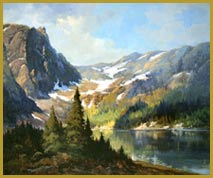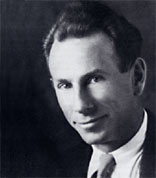| |
There
are millions of Robert Wood reproductions across America and around
the world. Dr. Carleton Palmer, Wood's dealer in Atlanta, Georgia,
actually found one in a chieftan's hut during an African safari.
Today people inherit Wood reproductions from their relatives, and
find them in thrift stores and swap meets. Unfortunately, because
of the large quantities that were published , these inexpensive
reproductions do not have significant value.
At
the peak of his popularity, Robert Wood was said to be the most
popular artist in the history of reproduction. His prints sold in
greater quantities than those of of the Old Masters or the French
Impressionists. These reproductions were "open editions"
that were published so that people who could not afford original
art would still be able to decorate their homes or offices with
something attractive. Viewers often chose Wood's prints from thousands
of others that graced the print catalogs. People were attracted
to them because of the pleasing compositions and crisp, clean color,
and the wide appeal of his chosen subjects. Another factor in Wood's
popularity was the fact that by the 1950s many artists had turned
their back on traditional, representational art, while he stayed
true to his own concept of painting.
Robert Wood seems to have first signed a contract that gave him royalties in exchange for the rights to reproduce his images in the 1920s, for the for the Harry Eichleay Company in Pittsburgh, Pennsylvania. His work was featured in print catalogs from a number of art publishers, including Brown and Bigelow in St. Paul, Minnesota; International Art Publishers in Detroit, Michigan; and the Donald Art Company in Port Chester, New York. Donald Bonnist of the Donald Art Company was the most successful of the publishers, and his firm sold millions of Wood's reproductions, which were usually produced in a few different sizes. Some of Wood's most famous works, including "October Morn," were purchased by Donald Bonnist of the Donald Art Company and graced their New York offices. In recent years Haddad's Fine Art Reproductions has continued publishing and distributing many of the most popular Robert Wood prints.
The royalties from the sales of reproductions made Wood wealthy as well as famous. Even though the royalties were only a few cents per print, Wood's works sold in such quantities that it gave him a considerable income. By the end of Wood's life his prints still sold steadily, if in much smaller amounts than in they had in earlier years. Today, the popularity of open edition prints has been largely supplanted by other forms of decorative art, but Wood's prints still appear in print catalogs and remain steady sellers. In the early 1970s, the American Express Company released a set of six limited edition serigraphs of Robert Wood paintings. American Express chose Wood to depict the National Parks, an ideal pairing of artist and subject. The production of these serigraphs was supervised and approved by Wood, making these 350-print sets the only truly limited editions of Wood's work. |
|



